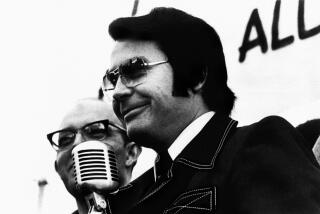A return to ‘Jonestown’
- Share via
Three years ago, Emmy Award-winning documentarian Stanley Nelson (“The Murder of Emmett Till”) was listening to radio interviews with surviving members of Jim Jones’ Peoples Temple on the 25th anniversary of the mass suicide of more than 900 of its members at Jonestown in Guyana, South America.
Previously, like “most Americans who were around at the time” of the suicides in 1978, he says, “I heard the story and thought it was about 900 crazy people who followed a madman down to Guyana and then for some unexplained reason committed suicide. It was a weird, fascinating story.”
So Nelson was surprised at how “sane” the former members sounded on the radio. “Their description of Peoples Temple was so different from what I knew,” he says. “They were not isolationists. They were very much part of the Bay Area community that was socially active. They preached integration. And they talked about their times in Peoples Temple and about the other members with a great deal of love. That is what got me thinking about it. How did these two stories exist in the same world? What was the truth?”
Nelson’s documentary, “Jonestown: The Life and Death of Peoples Temple,” which opens Friday in L.A., explores the history of the charismatic Jones, from his dysfunctional roots in Indiana to building an organization that advocated racial equality while providing food, clothing and shelter to the congregation and others.
But there was a dark side to Jones. And in the summer of 1977, New West magazine published an expose that detailed physical, sexual and drug abuse in the community and the fact that people were being held against their will.
Besides interviews with surviving members of the organization -- several of whom lost their wives and children on Nov. 18, 1978 -- including Jones’ adopted African American son, Jim Jones Jr., the documentary also features rare archival footage and audio material.
For Nelson, it was important to return to Jones’ Indiana roots and talk to his childhood friends. “His friends talked about that even as a young kid, he was not normal,” Nelson says.
“He had a fascination with death. He would kill cats so he could give them a funeral. From the very beginning, as a small boy, there is something happening [to him] under the surface, and as he gained more power, he started to be corrupted more absolutely until, by the end in Guyana, he was probably insane.”
*
-- Susan King



